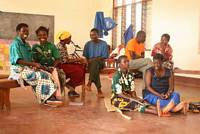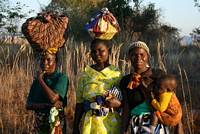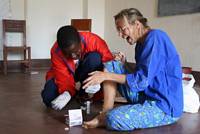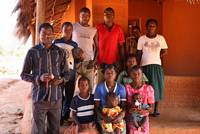From Church Leaders
[Source: Rebecca Vander Meulen, Head of Mission, Diocese of Niassa, December 2009]
Today, on World AIDS Day, I think of many people.

I think of Francisco and his wife and children, who walked five hours on Saturday to get medical care. Francisco carried his four-year-old feverish daughter and his wife Angela carried their baby son, who had bloody diarrhoea. Their daughter’s malaria test was negative, but she displayed generalized failure to thrive. Since one in six Mozambican adults are living with HIV, could HIV be what was making these children sick?
I think of William, who counselled Angela and Francisco. Though initially hesitant, they agreed to HIV testing, for the good of their children. We encourage couples to get counselled together, since it is important for each to know their spouse’s status. William is a very solid counsellor, despite having only finished grade 7. I was not present in the counselling and testing session (conducted in Nyanja, Francisco and Angela’s first language), but I am confident that William struck the right balance of science and empathy as he gave a positive result to Francisco and a negative result to Angela. He also taught them how to use a condom and explained to Angela that despite her negative test she might be positive — if she’d only recently contracted HIV and had not yet developed antibodies. Though their getting tested for HIV did not help the diagnose what ailed their children (HIV passes from the mother, not directly from the father), Francisco and Angela now have the knowledge that will help them live longer, thereby preventing their children from becoming orphans.

I think of João, who could die at any moment. He did not start on HIV treatment until he was very sick. He has used all his body’s fat reserves to fight against HIV and its opportunistic infections, so his face wrinkles, making him look far older than his 25 years. Not responding as dramatically as many do to antiretroviral HIV medication, my friend Peg (a British doctor) decided he was probably also fighting against TB — but might not survive the three-hour trip by car to the nearest health facility where TB testing is available.

I think of Peg, the British doctor who has taught me much of what I now about HIV and its management, and whose personal commitment to each and every patient stuns me.
I think of Lúcia, the overworked government nurse who yesterday generously interrupted her consultations with outpatient toddlers to organize TB medication for me to send to João.
I think of the dozens of mothers who waited for Nurse Lúcia with their sick children, most of whom are presumably sick with malaria (the rains have started falling, so the mosquitoes have started breeding) — but many of whom also probably have HIV but do not yet know it.
I think of João’s wife, Fatima, who has just tested positive for HIV. When she found out her result on Saturday, she was distraught. She had not yet met one of the dozens of activists who is HIV-positive and strong and healthy. To her, the face of HIV is that of her dying husband. But now she has the knowledge that will allow her to get appropriate treatment before she gets as sick as he is.
I think of Fatima’s 12-month-old daughter, Maria, whose preliminary HIV test gave a negative result—but whose result can only be confirmed with antibody testing once she turns eighteen months.

I think of Martins, who spent two hours on Saturday afternoon counselling Fatima. In all the HIV tests Martins had done to date (about a hundred, since he was trained as a testing counsellor in August), he’d never seen someone react so dramatically to the news that she was HIV-positive. Martins spends 18 days out of every month walking from community to community to bring HIV medications to dozens of stable patients so that they don’t have to spend four days a month walking to and from the health post to collect their drugs. He also mobilizes community support for the patients who, out of social pressure or despair or some other reason, have trouble adhering to their medication. (Martins also feeds 27 people daily at his house — some are his biological children, and many are orphaned or vulnerable children.)
I think of Ana, who was very sick nearly four years ago when ARVs first became available to her, but who is now healthy enough to farm and parent her children.
And I think of the 3900 Equipa de Vida activists who are voluntarily working to help people in their communities prevent HIV, go for testing, and adhere to treatment.
The people of whom I think are just a few of the 33 million people living with HIV, and the billions of us affected by it. Thanks for remembering today.
R. Vander Meulen
Lichinga, Mozambique
Diocese of Niassa (Anglican Church)